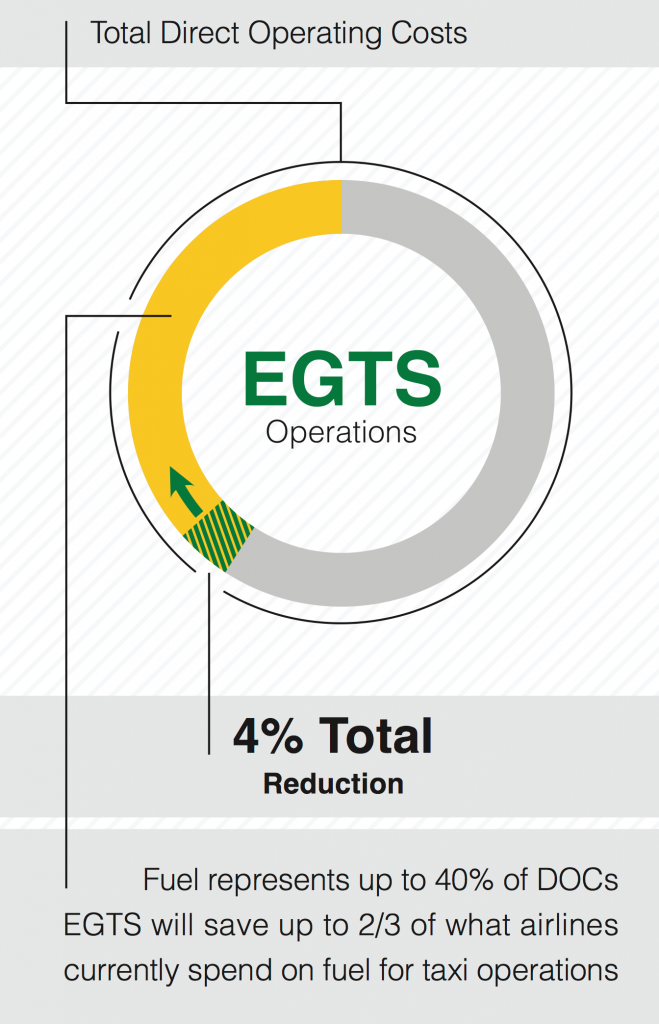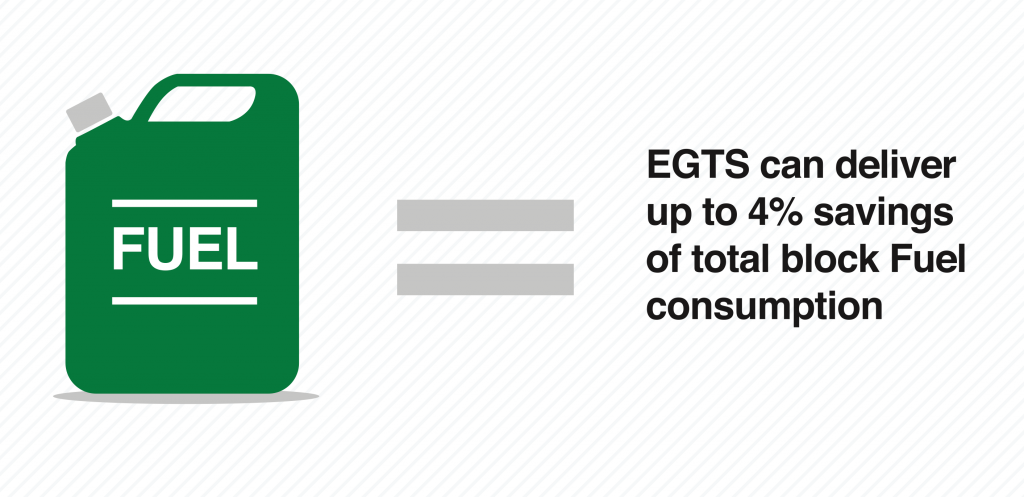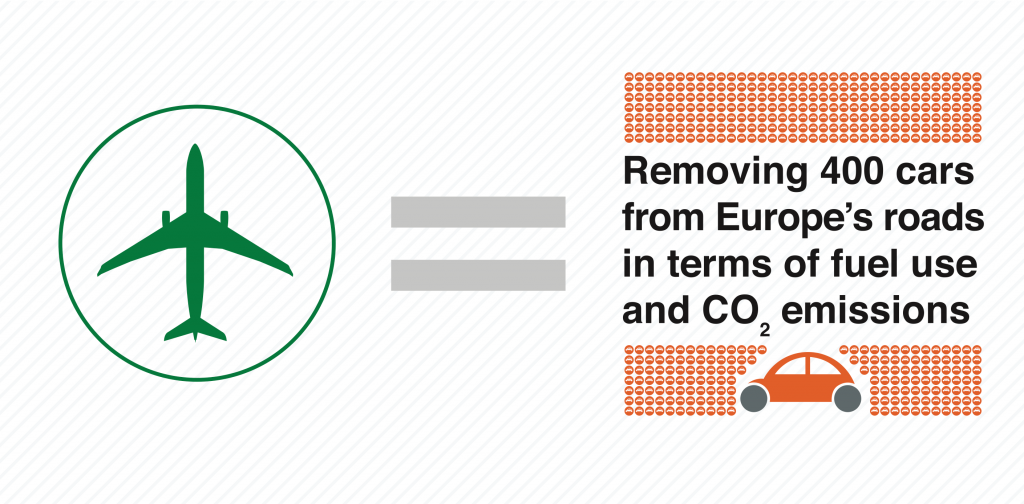Electric Green Taxiing System (EGTS) for Aircraft
by Thomas F. Johnson
With oil prices expected to remain at record levels and with continued volatility in the market, airlines look for new ways to save fuel and therefore money. Fuel costs are an ever-increasing drain on airline revenues and profits – accounting for up to 50% of airline direct operating costs. With this in mind, taxi operations represent a significant portion of airlines’ fuel costs – up to 6% of fleet fuel consumption for short-haul fleets operating single-aisle aircraft from congested airports. A single-aisle aircraft operates an average 2.3 total hours on the ground during 8-10 daily rotations. The global family of short-haul aircraft burns as much as five million ton of fuel per year during taxi operations alone. This amounts to an output of around 13 million tonnes of CO2 each year.
There is an ongoing global drive to cut carbon and nitrogen oxide emissions. Despite the introduction of more fuel-efficient and less polluting turbofan and turboprop engines, the rapid growth of air travel in recent years has contributed to an increase in total pollution attributable to aviation. Airports have an ongoing need to reduce emissions in their environment. When planning development, such as a new runway or terminal, they are obligated to undertake a review under the U.S. National Environmental Protection Act to look at what emissions would be created and attempt to minimize these impacts.
There are other environmental effects to be considered too. Noise in airport environments is regarded as intrusive and is likely to become more of an issue in future as business and residential growth expands. Jet blast issues around gate areas remain an important safety concern. The reliance on tugs for aircraft push back, can often result in take-off delays. If the push-back cart is defective or occupied, or the driver is on strike, the passengers have to wait for their departure. With an electric taxi system (integrated on an aircraft) they would just need the marshal to help guide them out or in. Any solution that could eliminate the need for tugs is an added bonus and would make the dispatch process faster and more autonomous.
The benefits to passengers of a tug-less approach to aircraft dispatches would be faster turnarounds. If the aircraft’s engines were not running when the aircraft arrives at the gate, ground-handling staff would be able to access the aircraft faster, more safely and commence arrival tasks. Passengers’ bags could, in theory, be unloaded faster and arrive on the carousel much earlier. Passenger disembarkation would be faster too. A number of initiatives are under way to develop integrated electric taxi solutions for aircraft. The search for viable electric taxiing solutions has been going on ever since the oil crisis of the 1970s. Currently both Boeing and Airbus are exploring the possibilities of electric taxiing or autonomous taxiing solutions and there are a number of potential solutions being brought to market.
The electric green taxiing solution (EGTS)
In 2011, Honeywell and Safran joined forces to develop an innovative new system that could significantly improve an airline’s operational efficiency, reducing fuel and other taxi-related costs (see Figure 1). It also provides environmental benefits by slashing carbon and other emissions created during taxi operations. The EGTS electric green taxiing system combines Safran’s extensive experience in integrated landing gear systems with Honeywell’s heritage in APU innovation. Their combined experience gives airline customers an attractive proposition and represents a viable and credible solution when it becomes available in 2018.
 |
| Figure 1 - EGTS reduce fuel costs |
So how does it work? The electric green taxiing system uses power from the aircraft’s Auxiliary Power Unit (APU) generator to electrically power motors fitted to the main landing gear wheels. Two of the main wheels are equipped with an electric motor, reduction gearbox and clutch assembly to drive the aircraft. The main landing gear wheels were chosen for maximized performance, traction and agility. Each of the aircraft’s powered wheels is equipped with an electro-mechanical actuator, while power electronics and system controllers give pilots total control of the aircraft’s speed and direction during taxi operations. The system allows an aircraft to push back without tug assistance and then taxi towards the runway without the main engines running. Once near the runway the aircraft’s main engines can be started. On landing, the aircraft can taxi off the main runway and then stop its engines. Then, using the APU power, it can engage the EGTS and taxi to the terminal and park at the gate, all without using the main engines.
Today’s turbofan engines are optimized for flying, not for powering aircraft on the ground. Every time an airliner taxis, it burns a disproportionate amount of fuel between gate and runway. This becomes even more of an issue for short and medium-haul aircraft, which spend a relatively long time taxiing between runway and gate, compared to the actual length of the flight. For an Airbus A320, for example, making a 500 nautical mile flight, it is estimated that EGTS will save up to 4% of block fuel costs, compared with standard taxiing procedures.
 |
| Figure 2 - Operational efficiency |
The environmental benefits are also compelling. One single aircraft using EGTS is the equivalent of removing 400 cars from Europe’s roads in terms of the fuel use and CO2 emissions, or 300 if you consider NOx emissions. As mentioned earlier, the system is specifically aimed at single-aisle aircraft, like the Boeing 737 and Airbus A320, which operate many daily flight cycles and therefore many taxi operations each day. EGTS therefore offers the maximum fuel savings for these types of operations.
 |
| Figure 3 -Reducing emissions |
Line maintenance time would be lowered because brake wear will be reduced and engine life extended – engines are prone to ingest large amounts of dust and debris when powering up on the ground at an airport. With EGTS the problem is reduced considerably. The project has received a lot of interest from the aviation industry. Damage and injury caused by debris and equipment blown by engines being run up on the ramp could also be eliminated.
The initial EGTS tests were recently completed in Montpellier, France, on an Airbus A320. The tests were to evaluate runway conditions and calculate the necessary loads needed for moving the aircraft on the ground and were very successful. We look forward to commercialization of this solution in 2018.
 Thomas F. Johnson is a Senior Advanced Technology Research and Development Project Engineer at Honeywell Engines in Phoenix, AZ. His work is mainly focused on Honeywell APU and its compatibility with airplanes’ propulsion engines. Prior to joining Honeywell in 2006, he was the Vice President Sales and Marketing of AAXICO (Miami, FL) for 3 years. He had also worked with Rockwell Collins (formally Kaiser Electroprecision), and Esterline Technologies Aero Manufacturing Company in Glendale, CA, where he received several patents. He holds two Bachelor of Science in Aviation Maintenance Technology and Business Administration, respectively, from Spartan College of Aeronautics and Technology and University of Phoenix (both are in Tulsa, OK), and a Master of Aeronautical Science degree from Embry Riddle Aeronautical University (Phoenix, AZ).
Thomas F. Johnson is a Senior Advanced Technology Research and Development Project Engineer at Honeywell Engines in Phoenix, AZ. His work is mainly focused on Honeywell APU and its compatibility with airplanes’ propulsion engines. Prior to joining Honeywell in 2006, he was the Vice President Sales and Marketing of AAXICO (Miami, FL) for 3 years. He had also worked with Rockwell Collins (formally Kaiser Electroprecision), and Esterline Technologies Aero Manufacturing Company in Glendale, CA, where he received several patents. He holds two Bachelor of Science in Aviation Maintenance Technology and Business Administration, respectively, from Spartan College of Aeronautics and Technology and University of Phoenix (both are in Tulsa, OK), and a Master of Aeronautical Science degree from Embry Riddle Aeronautical University (Phoenix, AZ).
About the Newsletter
Editors-in-Chief

Jin-Woo Ahn
Co-Editor-in-Chief

Sheldon Williamson
Co-Editor-in-Chief
TEC Call for Articles 2023 - Advances in Charging Systems
The TEC eNewsletter is now being indexed by Google Scholar and peer-reviewed articles are being submitted to IEEE Xplore.
To submit an article click here.


